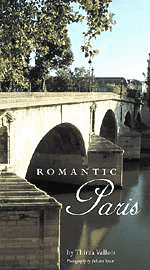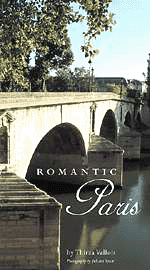Letters from Paris: Montmartre

- SUBSCRIBE
- ALREADY SUBSCRIBED?
BECOME A BONJOUR PARIS MEMBER
Gain full access to our collection of over 5,000 articles and bring the City of Light into your life. Just 60 USD per year.
Find out why you should become a member here.
Sign in
Fill in your credentials below.
 To find out the full story of Montmartre, and to walk its every nook and cranny, look up Around and About Paris/Volume III, published by Iliad Books, and Romantic Paris, published by Arris Books. Both books were written by Thirza Vallois.
To find out the full story of Montmartre, and to walk its every nook and cranny, look up Around and About Paris/Volume III, published by Iliad Books, and Romantic Paris, published by Arris Books. Both books were written by Thirza Vallois.
To order your copies of Around and About Paris and Romantic Paris: http://www.thirzavallois.com
Unfortunately, I live on the wrong side at Paris, as far as Montmartre goes. At one point I owned a flat on the quiet, exquisitely untouristy rue Caulaincourt. In those days I used to get there more regularly and would hang around the neighbourhood, shopping and lunching with regulars in its unfussy, excellent restaurants.
Then I sold my flat, (and that’s a story or a book in itself), and my Montmartre escapades petered out. Nowadays, I only visit Montmartre for specific reasons, often when visitors are in town, providing me with a good excuse to take a holiday from Paris, whilst remaining in Paris all the same. Paradoxically, Montmartre is at once the most quintessentially Parisian part of Paris, yet worlds apart; at once a miniature Paris, within Paris, yet way outside, a village within the big "village" and excitingly above. You don’t just go to Paris from Montmartre-you go down to Paris, always reluctantly. I much prefer it the other way round, when the thrill of anticipation makes up for the exhausting climb up the appropriately named rue du Calvaire, for instance, an interminable steep flight of steps rather than a street.
True, Montmartre is an exaggerated, picture-postcard, bigger-than-size Paris, a mythology fabricated by Hollywood (and now also by Amélie). My one-time rue Caulaincourt is the very one that contains the bridge by the same name, where Irma La Douce sang "There is no cure, for l’amour, on the bridge of Caulaincourt". Contrary to what I had believed as a romantic teenager, when I knew little about Paris, the bridge doesn’t span the Seine at all, but the unlikely site of the Cemetery of Montmartre. Inaugurated in 1888 by the Paris Prefect, Monsieur Poubelle (the inventor of the dust-bin, who also bequeathed to it his name), it was a major event which opened up the hill to the rest of the city lying below. Today it still provides one of the two main accesses to Montmartre, if you are driving.
Forget about the Sacre Coeur (other than the stunning view from its foot), and the mobbish place du Tertre and thereabouts (forgive me for sounding snooty); "shuttle" instead between the rue des Abbesses/rue Lepic for your foody bustle and the vineyard/Musee de Montmartre/le Lapin Agile area for bucolic serenity. Each is wonderful in its own way. My Montmartre walks in both Around and About Paris and Romantic Paris take you practically to every nook and cranny on the Butte. And if you choose to explore the hill on an early morning of spring or summer, you will be thrown back to the times of Renoir, when he lived with Aline and the children in the secret hideaway of le Château des Brouillards, "a paradise of roses and lilac". Renoir’s studio was in the little house that now shelters the Museum of Montmartre. It was in its charming garden that he painted The Swing.
The first of my two most recent escapades took me to Coquelicot, at 24 rue des Abbesses, a boulangerie/café/eaterie, where everything is as sunny and bright as a poppy, and touched by a subtle air of Provence. I would have never got there if it hadn’t been for Erica, my friend from California who was visiting me and is poppy mad. Erica’s other passion being chocolate, it is thanks to her that I first discovered Denise Acabo’s treasure trove, A l’Etoile d’Or, on rue Fontaine, across the Boulevard de Clichy from the Moulin Rouge. Faithful to its name, Coquelicot had poppy decorations everywhere, and a stunning bunch of them, which had been rescued from Kenzo’s promotional campaign for that recent scent. The weather being as bright as the poppies, we settled on the sunny terrace for the sake of the congenial bustle on the street and the freshness of the food served. Not to mention the crusty bread. You can choose between breakfast, brunch or any light food à la carte, which I chose to wash down with fresh fruit juice and finish off with a delicious tarte à la rhubarbe. My only regret was to see it disappear from my plate, which had very few crumbs left by the time the table was cleared for coffee. Be warned: the pavement being narrow, there are few tables outside, and since the food is excellent, and reasonably priced, finding a place in the sun is not guaranteed, and almost impossible at peak times.
From rue des Abbesses to rue Lepic is but a stone’s throw. At the bottom of the street is the famous Moulin Rouge, at no. 54 lived Van Gogh and his brother Theo, and even if the greengrocer’s in Amélie is not one of those that line the bottom of the street, the feel is exactly the same. Having bought a heap of cherries for roughly half the price of what I paid for them yesterday on rue Mouffetard, I made my way home, heavily loaded but pleased with my bargain, yet, as usual, a bit sentimentally sad to leave the hill. I always am. Though this time not for long. Within a few days, a new bunch of visitors was in town, providing me with a renewed excuse to retrace my steps to Montmartre, but to the countrified pocket by the vineyard rather, where the legendary restaurant, Le Beauvilliers is situated, drowning in greenery on the quiet side of rue Lamarck. My one-time flat on rue Caulaincourt is round the corner, and it’s from rue Caulaincourt that you should reach the restaurant, if you want the full, bucolic effect, up the leafy flight of steps of rue de l’Abbé Patureau. (Have you noticed that in Montmartre flights of steps are for streets what the canals are in Venice?)
Although I had celebrated the place profusely in my book Romantic Paris, I hadn’t been back to Le Beauvilliers for a while and was very upset to be informed on the phone that owner/founder and chef Edouard Carlier had passed away of a sudden heart attack. I should have known, as the entire community of Montmartre was orphaned by his death and deeply mourned him, Carlier being one of its pillars. Home to celebrities of all shades and colours, politicians, artists, what have you, the Beauvilliers’ celebrations of the Russian New Year were renowned throughout the upper circles of sophisticated Paris. I was hesitant to go back under the circumstances but was reassured by the pleasant voice on the phone that nothing had changed. I also appreciated the delicacy of that voice that put no pressure on me, being aware of my dilemma. I am glad I decided to come back, almost like paying my tribute to the wonderful Carlier, whose beaming face still watches over the community of diners from the wall in the entrance. Besides, the food couldn’t have been better, and the atmosphere couldn’t have been pleasanter!
Mike, who is now the master of the place, has made sure to keep the torch alive and nothing has changed. The same medley of the Second Empire and the Belle Epoque surrounded our dinner, intact, dripping with fine period china, silverware and crystal. Likewise, the tall bouquets of flowers were as exuberant as those touched by the late Carlier. More importantly, the tradition of high gastronomy has been perpetuated too, entrusted to the expert hand of Monsieur Kapler. After all, it’s a responsibility for an establishment to bear the name of Antoine Beauvilliers. In case you don’t know it, he was the chef of Marie Antoinette and of her brother-in-law the Comte de Provence, later to become Louis XVIII. By naming his restaurant after the great chef, back in 1974, Edouard Carlier made a pledge to respect the highest traditions of French gastronomy.
Our night was exquisite, opened with a Bellini cocktail of champagne and peach liqueur. Both colour and taste were just right for the month of June, although the real Montmartre thing I normally go for is the Poulbot cocktail, which celebrates the famous artist and friend of all the hill’s children, and replaces the peach with a variety of red berries. There followed an entrée of raviole à la homard, subtly flavoured with tarragon, that sent me straight to heaven, then a succulent piece of lamb sitting on a bed of aubergines as a main course, and finally, having skipped the mouthwatering plateau de fromage for the sake of my figure, I yielded to the much more pernicious millefeuille. The puff pastry was as light as feather, as was the wonderful snow-white cream, and the strawberries that decorated it tasted as though they had just been picked from the garden. The wines were on a par with the rest, suggested kindly by Marc Moine. There is no need to feel embarrassed about asking for advice; nobody minds if you are “ignorant” these days. We had two Mercureys, one white one red, a côte chalonnaise Bourgogne which accompanied harmoniously the wonderful evening.
Indeed, close to 70 years later, I in turn took an American friend to one of those expensive restaurants in the lower Champs-Elysées. It was also in June, the weather was heavenly, as was the food, and we dined in the shade of a spreading chestnut tree. My friend was overwhelmed that we sat at the table for three full hours. As for me, I could have stayed there all day long…
Our night at Le Lapin Agile was somewhat curtailed, but I’ll be back soon again. Despite changing times, despite the ticking of the clock, despite the tourist industry, the little cottage-come-cabaret, opposite the vineyard, has remained timeless, and still celebrates the anarchical spirit of old Montmartre through witty songs and jokes, which most tourists can’t get. It’s totally unimportant, because they can enjoy the melodies and the warm voices, which they do. A very sweet and young Japanese couple was sitting next to me who, clearly, understood nothing, but whose faces were beaming with joy. There are plenty of French people in the audience, too, a guarantee for you that the place has remained genuine.
Coquelicot 24 rue des Abbesses, Tel 01 46 06 18 77
A l’Etoile d’Or, 30 rue Fontaine, Tel 01 48 74 59 55
Le Beauvilliers, 52 rue Lamarck, Tel 01 42 54 54 42
Le Lapin Agile, 22 rue des Saules, Tel 01 46 06 85 87
Thirza Vallois is the author of Around and About Paris, Volume I, II, III published by Iliad Books, UK. Romantic Paris, co-published by Interlink Publishing Group, US and Arris Books, UK. Available at http://www.thirzavallois.com. Her forthcoming book on the Aveyron is due to be published next year.


